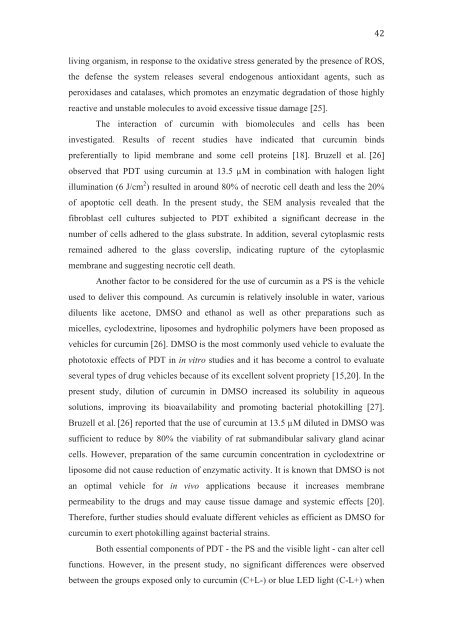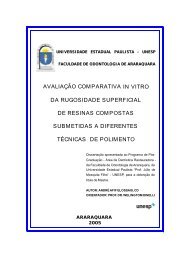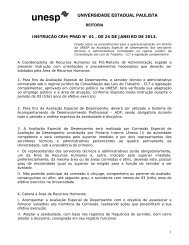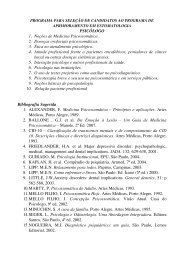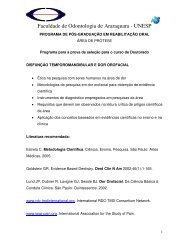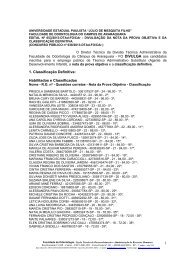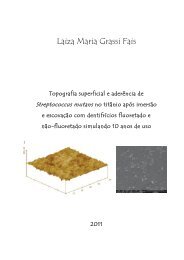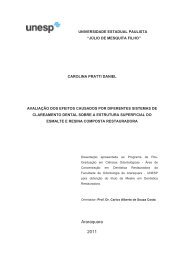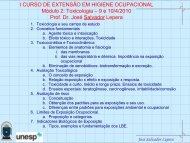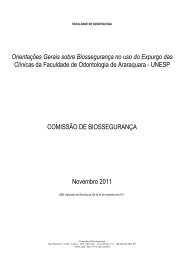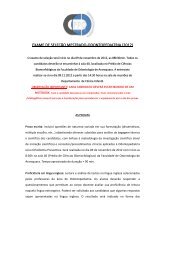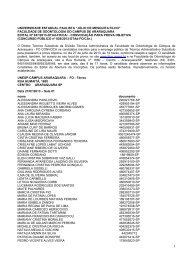PS for photodynamic inactivation of the bacteria. Those authors observed more PDTresistantMRSA strains compared with the MSSA strains, as observed in the presentstudy. Tsai et al. [22] also found that the PDT susceptibility of MRSA strains waslower than the other antibiotic-susceptible strains. This greater resistance of MRSAstrains to PDT has been related to the capsular polysacchari<strong>de</strong> structure on thebacterial cell surface, which would limit the penetration of the PS into the MRSAcells, reducing the toxic effects of the ROS generated during photodynamicinactivation [23]. The need for higher light fluences and drug concentration forresistant strains have been also observed for yeasts, showing that fluconazole-resistantC. albicans and C. glabrata strains had reduced sensitivity to PDT [12]. It is acceptedthat PDT is a non-specific and effective treatment against both susceptible andresistant pathogen [22]. Until now, the studies reported that PDT effect is strain andisolate-<strong>de</strong>pen<strong>de</strong>nt. In our study, the ATTC evaluated strains presented the behavior ofsusceptible bacteria being more sensitive to PDT treatment than the resistant bacteria.However, Grinholc et al. [14] reported on MRSA isolates highly sensitive to PDT,whereas there are some other MRSA isolates resistant to its effects [14,22]. Therefore,it is relevant to evaluate the susceptibility of resistant microorganisms to PDT in or<strong>de</strong>rto <strong>de</strong>termine whether it can be used in the treatment of infections in which theprevalence of these microorganisms has increased at alarming rates.In the same way, it is important to investigate the potential toxic effects ofPDT to the host’s cells, which are also susceptible to the action of ROS. In the presentstudy, the metabolism of cultured fibroblast cells <strong>de</strong>creased by 68.1, 75.1 and 80% inresponse to exposure to curcumin at 5, 10 and 20 µM concentrations, respectively, incombination with blue LED light illumination. Similarly, in a previous study,porphyrin-mediated photodynamic therapy reduced the viability of human <strong>de</strong>rmalfibroblasts by 66.5% and caused photodynamic inactivation of 99.9% of MRSA [14].Even consi<strong>de</strong>ring that the reduction of cell metabolism was accentuated in our study,it was not sufficient to cause complete inhibition of the SDH enzyme, suggesting thatboth MSSA and MRSA strains were more susceptible to PDT than the L929fibroblasts. Dovigo et al. [24] obtained similar results when the same parameters usedfor fungal cells were applied for macrophage cell culture. While a completephotokilling was achieved for C. albicans planktonic cells, the macrophagesmetabolism was not completely reduced. Despite the significant reduction of cellmetabolism, the in vitro experiments cannot reproduce all in vivo conditions. In a
living organism, in response to the oxidative stress generated by the presence of ROS,the <strong>de</strong>fense the system releases several endogenous antioxidant agents, such asperoxidases and catalases, which promotes an enzymatic <strong>de</strong>gradation of those highlyreactive and unstable molecules to avoid excessive tissue damage [25].The interaction of curcumin with biomolecules and cells has beeninvestigated. Results of recent studies have indicated that curcumin bindspreferentially to lipid membrane and some cell proteins [18]. Bruzell et al. [26]observed that PDT using curcumin at 13.5 µM in combination with halogen lightillumination (6 J/cm 2 ) resulted in around 80% of necrotic cell <strong>de</strong>ath and less the 20%of apoptotic cell <strong>de</strong>ath. In the present study, the SEM analysis revealed that thefibroblast cell cultures subjected to PDT exhibited a significant <strong>de</strong>crease in thenumber of cells adhered to the glass substrate. In addition, several cytoplasmic restsremained adhered to the glass coverslip, indicating rupture of the cytoplasmicmembrane and suggesting necrotic cell <strong>de</strong>ath.Another factor to be consi<strong>de</strong>red for the use of curcumin as a PS is the vehicleused to <strong>de</strong>liver this compound. As curcumin is relatively insoluble in water, variousdiluents like acetone, DMSO and ethanol as well as other preparations such asmicelles, cyclo<strong>de</strong>xtrine, liposomes and hydrophilic polymers have been proposed asvehicles for curcumin [26]. DMSO is the most commonly used vehicle to evaluate thephototoxic effects of PDT in in vitro studies and it has become a control to evaluateseveral types of drug vehicles because of its excellent solvent propriety [15,20]. In thepresent study, dilution of curcumin in DMSO increased its solubility in aqueoussolutions, improving its bioavailability and promoting bacterial photokilling [27].Bruzell et al. [26] reported that the use of curcumin at 13.5 µM diluted in DMSO wassufficient to reduce by 80% the viability of rat submandibular salivary gland acinarcells. However, preparation of the same curcumin concentration in cyclo<strong>de</strong>xtrine orliposome did not cause reduction of enzymatic activity. It is known that DMSO is notan optimal vehicle for in vivo applications because it increases membranepermeability to the drugs and may cause tissue damage and systemic effects [20].Therefore, further studies should evaluate different vehicles as efficient as DMSO forcurcumin to exert photokilling against bacterial strains.Both essential components of PDT - the PS and the visible light - can alter cellfunctions. However, in the present study, no significant differences were observedbetween the groups exposed only to curcumin (C+L-) or blue LED light (C-L+) when
- Page 1: UNESP - UNIVERSIDADE ESTADUAL PAULI
- Page 4 and 5: Dados CurricularesAna Paula Dias Ri
- Page 6 and 7: Dedico este trabalho...Aos meus pai
- Page 8 and 9: Dedico este trabalho... Ao meu amor
- Page 10 and 11: Giampolo. Obrigada por me incentiva
- Page 12 and 13: À Lívia, Juliana, Fernanda Alves,
- Page 14 and 15: “Não basta ter belos sonhos para
- Page 16 and 17: Resumo
- Page 18 and 19: indicando que a membrana citoplasm
- Page 20 and 21: Abstract
- Page 22 and 23: using the different delivery system
- Page 24 and 25: 1 IntroduçãoA Terapia Fotodinâmi
- Page 26 and 27: hospitalares 48 . Sabe-se que a col
- Page 28 and 29: (Linn), conhecida como açafrão da
- Page 30 and 31: 2 Proposição
- Page 32 and 33: 3 Capítulos
- Page 34 and 35: Phototoxic effect of Curcumin on me
- Page 36 and 37: than non-resistant strains. At the
- Page 38 and 39: inactivation (5, 10, 20 μM) and th
- Page 40 and 41: concentrations (5 and 10 μM) signi
- Page 44 and 45: compared with the negative control
- Page 46 and 47: esistant Staphylococcus aureus (199
- Page 48 and 49: 27. Kurien BT, Scofield RH (2009) H
- Page 50 and 51: Figure 3: Graphic representation of
- Page 52 and 53: 3.2 Capítulo 2Photodynamic inactiv
- Page 54 and 55: IntroductionCandida albicans is a c
- Page 56 and 57: medium and increases the possibilit
- Page 58 and 59: The microorganism used in this stud
- Page 60 and 61: Estimation of membrane damage by fl
- Page 62 and 63: Statistical analysisFor the purpose
- Page 64 and 65: with damaged cytoplasmic membrane.
- Page 66 and 67: 7A). As observed for the free ClAlP
- Page 68 and 69: demonstrated in previous studies (2
- Page 70 and 71: In order to evaluate the possible e
- Page 72 and 73: fluorescence on hyphal forms than y
- Page 74 and 75: 7- Chatterjee, D. K., L. S. Fong an
- Page 76 and 77: 20- Dovigo, L.N., A. C. Pavarina, A
- Page 78 and 79: 33- Chandra, J., D. M. Kuhn, P. K.
- Page 80 and 81: FIGURES: Figure 1: Line graphic re
- Page 82 and 83: A B CFigure 5. A: Overview of a 33.
- Page 84 and 85: 3.3 Capítulo 3Antimicrobial photod
- Page 86 and 87: the highly reactive singlet oxygen
- Page 88 and 89: give a 600 mM stock solution. Befor
- Page 90 and 91: washed out. Aliquots of 150 μL of
- Page 92 and 93:
control (p˂0.05); the other contro
- Page 94 and 95:
ClAlPc or diluted in DMSO. On the o
- Page 96 and 97:
In addition to the photodynamic eff
- Page 98 and 99:
Authors Contribution:All authors ha
- Page 100 and 101:
Lambert PA (2002) Cellular impermea
- Page 102 and 103:
FiguresFigure 1. Line graphic repre
- Page 104 and 105:
Figure 5. Box-plot graphic represen
- Page 106 and 107:
4 DiscussãoA Terapia Fotodinâmica
- Page 108 and 109:
antibioticoterapia 80 . Entretanto,
- Page 110 and 111:
Sabe-se que o DMSO não representa
- Page 112 and 113:
como a membrana nuclear 19 . Dessa
- Page 114 and 115:
esultando em comportamento semelhan
- Page 116 and 117:
A investigação do efeito antimicr
- Page 118 and 119:
5 Conclusão
- Page 120 and 121:
as maiores doses de luz avaliadas.
- Page 122 and 123:
6 Referências ∗1. Allison RR, Mo
- Page 124 and 125:
22. Dovigo LN, Pavarina AC, Mima EG
- Page 126 and 127:
41. Kussovski V, Mantareva V, Angel
- Page 128 and 129:
59. Primo FL, Bentley MV, Tedesco A
- Page 130 and 131:
80. Tsai T, Yang YT, Wang TH, Chien
- Page 132 and 133:
7 ApêndiceNesta seção estão apr
- Page 134 and 135:
Tabela A1- Valores originais de ufc
- Page 136 and 137:
Tabela A7- Medidas de resumo, em lo
- Page 138 and 139:
B- Avaliação de diferentes concen
- Page 140 and 141:
Tabela A15- Sumário da Análise de
- Page 142 and 143:
Tabela A19- Sumário da Análise de
- Page 144 and 145:
Tabela A21- Valores originais de lo
- Page 146 and 147:
Tabela A24- Valores originais de ab
- Page 148 and 149:
Tabela A27- Valores originais obtid
- Page 150 and 151:
Tabela A28- Resultado das comparaç
- Page 152 and 153:
Testes foram realizados para verifi
- Page 154 and 155:
Tabela A33- Valores originais de lo
- Page 156 and 157:
Tabela A36- Resultado do teste de c
- Page 158 and 159:
Tabela A39- Valores originais de ab
- Page 160 and 161:
Tabela A43- Resultado do teste de c
- Page 162 and 163:
Tabela A46- Medidas de resumo de ab
- Page 164:
Autorizo a reprodução deste traba


